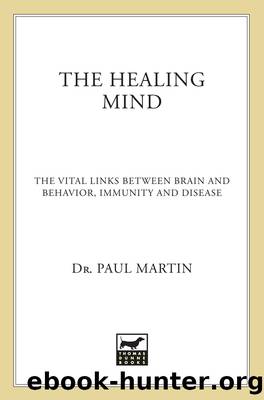The Healing Mind by Paul Martin

Author:Paul Martin
Language: eng
Format: epub
Publisher: St. Martin's Publishing Group
8
Sick at Heart
We boil at different degrees
Ralph Waldo Emerson, Society and Solitude (1870)
Hearts and minds
In this chapter we shall examine how interactions between the mind and the body impinge upon heart disease, the biggest single cause of death in modern industrialized nations. Heart disease accounts for more than 40 per cent of all deaths in most developed countries. In Britain, for example, almost half of all deaths result from heart disease, as against a quarter from the second biggest killer, cancer. (Infectious diseases, which headed the league table in previous centuries, now claim less than one death in two hundred.) But first, what is heart disease?
To stay alive, our brain, muscles and other body tissues need a constant supply of oxygen and nutrients from the blood. To meet this demand the heart must pump between 5 and 15 litres of blood every minute, at a rate that varies according to current needs. The heart is itself a muscle, and a busy one to boot. More than any other muscle in the body it demands a constant supply of blood.
Interrupting the blood supply to the heart can damage part of the heart muscle through lack of oxygen, causing a heart attack (or myocardial infarction). This, in turn, may cause the heart to stop pumping altogether (cardiac arrest). Disease of the heart or blood vessels can also result in an interruption of the blood supply to the brain, better known as a stroke. In the interests of brevity, I shall use the term heart disease in its general sense, meaning diseases of the heart and its associated blood vessels.
Of all types of heart disease it is coronary heart disease, otherwise known as coronary artery disease, which claims the highest number of victims (accounting for about 80 per cent of all heart disease in industrialized nations). The term in fact covers a variety of disorders affecting the coronary arteries â the blood vessels supplying the heart muscle itself. Thanks to a process called atherosclerosis, the coronary arteries thicken and stiffen, and their internal diameter is reduced by the progressive build-up of scar tissue and fatty deposits (or plaques).
Atherosclerosis is a silent, progressive disorder. It develops gradually over a period of years and initially produces no outward signs that anything is amiss. Atherosclerosis can affect arteries anywhere in the body, but is most serious when it attacks the arteries supplying the heart or brain. If the victim is lucky, he or she will receive warning signs in the form of recurrent chest pains known as angina. The pain indicates that sections of the heart muscle are being deprived of oxygen. For unlucky atherosclerosis sufferers, there will be no warning signs; the disease will first manifest itself in the form of a fatal heart attack or stroke. During the Korean War autopsies on American soldiers killed in action revealed that 77 per cent of them had some degree of atherosclerosis, even though they had all been considered fit and healthy.
Decades of intensive research have revealed a great deal about the nature and origins of heart disease.
Download
This site does not store any files on its server. We only index and link to content provided by other sites. Please contact the content providers to delete copyright contents if any and email us, we'll remove relevant links or contents immediately.
| Anatomy | Bacteriology |
| Biochemistry | Biostatistics |
| Biotechnology | Cell Biology |
| Embryology | Epidemiology |
| Genetics | Histology |
| Immunology | Microbiology |
| Neuroanatomy | Nosology |
| Pathophysiology | Physiology |
| Virology |
Tuesdays with Morrie by Mitch Albom(4733)
Yoga Anatomy by Kaminoff Leslie(4334)
Science and Development of Muscle Hypertrophy by Brad Schoenfeld(4104)
Bodyweight Strength Training: 12 Weeks to Build Muscle and Burn Fat by Jay Cardiello(3941)
Introduction to Kinesiology by Shirl J. Hoffman(3744)
How Music Works by David Byrne(3235)
Sapiens and Homo Deus by Yuval Noah Harari(3033)
The Plant Paradox by Dr. Steven R. Gundry M.D(2583)
Churchill by Paul Johnson(2544)
Insomniac City by Bill Hayes(2523)
Coroner's Journal by Louis Cataldie(2459)
Hashimoto's Protocol by Izabella Wentz PharmD(2352)
The Chimp Paradox by Peters Dr Steve(2343)
The Universe Inside You by Brian Clegg(2114)
Don't Look Behind You by Lois Duncan(2104)
The Immune System Recovery Plan by Susan Blum(2041)
The Hot Zone by Richard Preston(1996)
Endure by Alex Hutchinson(1993)
Woman: An Intimate Geography by Natalie Angier(1909)
